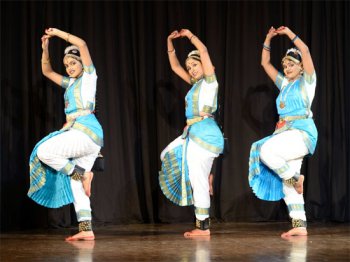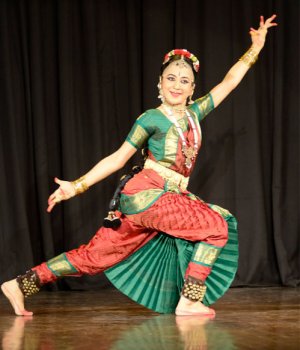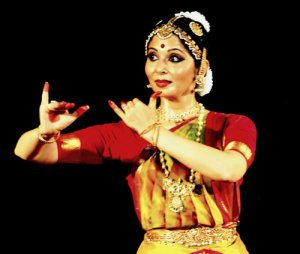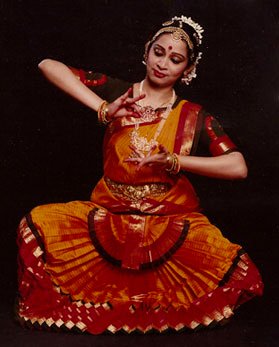
|   |

|   |
Festival of Varnams - Dr Sunil Kothari e-mail: sunilkothari1933@gmail.com May 20, 2013 After the successful presentation of Margam/Varnams at Andhra Sabha Auditorium in New Delhi a few months ago, Usha RK, a cultural activist, organizer and firm believer in traditional Bharatanatyam Margam repertoire, in association with India International Centre (IIC) and Kalasindhu, a Bangalore based institution run by Poornima Gururaja, presented a two day festival of Margam / Varnams on 9th and 10th May 2013 at India International Centre's auditorium. On each evening two sets of artistes performed. Opening the festival, Usha RK explained the purpose of this festival:"With a view to keep the traditional format of Bharatanatyam alive with its most important item, the Varnams. The format has seen various changes over the years, the duration reduced due to lack of time. The format has seen a huge amount of polishing and sophistication in its presentation. The Varnam has also been compromised on in some ways. To revive the traditional compositions of Varnams, this festival was conceptualized. From Bangalore, we have come with a hope to showcase not only the senior, accomplished dancers, but also to present upcoming dancers who need a platform to display their sadhana and expertise, seeking their place in the sun."  Swathi, Priyanka and Deepthi Photo: Rajiv Gupta In solo number, Swathi presented the melodious composition "Bhavayami gopala balam" popularized by MS Subbulakshmi in Yaman Kalyani, of Annamacharya in an endearing manner. In Tamil padam "Yaro ivar yaro" in Sahana and adi talam, Deepthi, as the nayika asks her sakhi, who is that one, where does he hail from? She enacted the confusion in a telling manner. Pattanam Subramanya Iyer's Javali "Yera ra ra" in Khamas performed by Priyanka was lively. She succeeded in expressing the seductive bhavas with ease and displayed flair for abhinaya. The enchantment, offering betel leaf, garland, drink, to the nayaka, preparing a bed and behaving in a coy manner - all tantalizing gestures were registered well by her, communicating her understanding of the javali. The three together concluded the program with a brief tillana in Jog raga and adi tala. The musicians with G Elangovan for vocal, Raghuraman for flute, Ramesh for mridangam, Chakrapani for violin and nattuvangam by Poornima Gururaja, did not create an impression of togetherness. On account of new set of musicians in Delhi and no adequate rehearsals, there were obvious glitches at various places. It can happen on account of various reasons, so the organizers would do well to take these factors also into account when performing in the Capital, where the discerning audiences can spot the inadequacies. The nattuvangam also looked under weather, but the dancers managed to go through their paces. Unless the teamwork of the musicians and dancers are in synch, the purpose of presenting young talent gets defeated.  Aishwarya Nityananda Photo: Rajiv Gupta She followed the number with abhinaya to a padam "Theruvil varaano" composed by Muthu Tandavar in praise of Lord Nataraja. It dwelt upon the immense love and devotion of the nayika for her lord Chidambaram Nataraja. She wonders about meeting him on the route that her street belongs to. She wishes that the Lord may glance at her for a moment, For her the supreme being, who had destroyed Tripura instantly with one arrow, it was her intense wish that he halt at her door and she would conquer his love by surrendering at his feet. She declares her love for him. The sancharis enacted by Aishwarya were dramatic and reflected her intensity. She has an ability to express feelings in a quicksilver manner and it comes to her without any effort. Unlike a lesson she has remembered after being taught by her guru, she evolves on her own and invests the dance with freshness, drawing attention of the spectator to minute details which embellish her art. Aishwarya concluded her performance with a krithi in raga Nadanamakriya in mishra jhampa tala. In this well known composition of Maharaja Jayachamarajendra Wodeyar, who was a devotee of Lord Shiva, the devotee begs of the Lord to forgive his sins committed knowingly or unknowingly. The devotee describes him as an embodiment of all the five elements and prays to him to free the devotee from the cycle of birth and death. Aishwarya enacted the events with narration of Lord as consort of Parvati, destroyer of Tripurasura and Manmatha, and friend of Kubera. The krithi gave her scope to display her flair for expressions. Even when Aishwaraya performed to recorded music, her performance was full of warmth and intensity and gave the connoisseurs pleasure of watching one so gifted. She is doubtless a bright exponent and deserves to be seen more often in festivals. She has a capacity to hold the attention of the audiences from the word go, and leaves an indelible impression with her non aggressive, subtle approach.  Priya Venkataraman
Photo: Karan Kapoor In ashtapadi "Nath hare, sidati Radha vasagrihe" from the Gita Govinda, Priya showed restraint in her abhinaya as studied from Bragha Bessel. Approaching Krishna, the sakhi begs of him to go unto Radha who is looking for him in all directions, mistaking him in various images, embracing him and getting disillusioned, unhappy, waiting for him. As a vaskasajja, she is awaiting Krishna. She has lost sense and fumbles when walking in search of Krishna, that state of hers should make Krishna take pity on her. As a sakhi describing Radha's state, Bragha seems to underplay the emotions. For addressing Lord as Jagannath, Dr. Subas Pani had suggested to Priya to depict him as the Lord of the Universe who should display compassion towards Radha. Dr. Balamurali Krishna's Tillana in Kathanakuthuhalam raga is a favourite among dancers. Priya's rendering was full of joyous feelings and wove nritta patterns which included covering of the stage space admirably. Embellishing with sculpturesque poses, going in circle suggesting playing rasalila with delightful utplavanas, Priya danced minus razzle dazzle, retaining the structural beauty of Bharatanatyam. Since all the three numbers centred round Krishna, Priya would do well to select more variety in a short program of this nature. A javali that would bring a touch of humour and would have appeal on more human level in contrast to sheer devotion would give scope for expressions enhancing the varied range of emotions.  Poornima Gururaja
Photo: Rajiv Gupta Poornima began her performance with a shloka in praise of Lord Subramanya , delineating the Subramanya Mantram which describes him as the destroyer of all enemies. He showers blessings on his devotees. There was an interesting reference to his being born in the forest of the 'shara.' The Varnam which Poornima had selected was a composition of Pandanallur Srinivasan in raga Abhogi and adi tala. The refrain was "Senthil maanagar vazhum singara velanai." The interesting episode was of Subramanya admonishing Brahma for his not being able to explain the concept of Om. The sancharis which captivated one's attention were when Poornima danced it showing how Subramanya explained and confided the Mantra OM to his father, Lord Shiva. The alternating nritta passages were layered and with Indira Rajan wielding cymbals, the entire presentation was exciting. In the audience were Yamini Krishnamurty, Swapnasundari and Prathibha Prahlad, who kept the tala in consonance with Indira's nattuvangam. It was a fascinating sight to see the complete involvement of these dancers to the presentation and enjoying it thoroughly. Poornima danced with aplomb and as best as she could. It was indeed discrete of her not to attempt leg extensions or cover the stage with utplavanas. She seemed to have practiced with Indira Rajan well and the result was satisfactory. Poornima has an expressive face and registered bhavas with ease. It was obvious that she and the accompanying musicians were on the same wavelength. The Kshetrayya padam "Suguna Venugopala" in raga Sahana set to mishra chapu tala was enacted with deep anguish and emotion. The nayika tells her beloved that he is in her heart and very dear to her. But the one, who she married her as a child, was now calling, therefore she had to go but she would return soon. The stanza "Mugudochi pilichevu poyevatsuna preeti" is heart rending as the nayika tells Venugopala not to forget her. The beautiful stanza follows mentioning that there is a physical distance between the blossomed lotus and the sun but the rays attract the lotus. Similarly while the nayika is physically away, she tells him that it is his lotus feet that she would ultimately surrender to. She tells her beloved that she only thinks of him all the time and misses being with him, nevertheless she says that she is brave and confident she would come back to him. The pleadings by her to the nayaka were very moving and Poornima did justice to the text in a poignant manner. The sancharis of their childhood games, she making towers in the sand, he coming and breaking them, their reconciliations etc., were enacted with feeling. Poorrnima concluded with tillana in raga Shankarabharanam set to rupaka tala. The mangalam "Rajiva nayana pavamana sudutupattu" composed by Thyagaraja resonated in the auditorium and it was an endearing evening when many local dancers, rasikas and lovers of Bharatanatyam met Indira Rajan. They complimented Poornima, other dancers, musicians including vocal by Vasanthi Krishna Rao, mridangist Arun Kumar, violinist VSK Annadurai, flautist Ramakrishnan and the indefatigable organizer Usha RK who compered the shows with her usual flair.  Dr. Sunil Kothari is a dance historian, scholar, author and a renowned dance critic. He is Vice President of World Dance Alliance Asia Pacific India chapter, based in New Delhi. He is honored by the President of India with Padma Shri, Sangeet Natak Akademi award and Senior Critic Award from Dance Critics Association, NYC. He is a regular contributor to www.narthaki.com, the roving critic for monthly magazine Sruti and is a contributing editor of Nartanam for the past 12 years. Post your comments Pl provide your name and email id along with your comment. All appropriate comments posted with name and email id in the blog will also be featured in the site. |